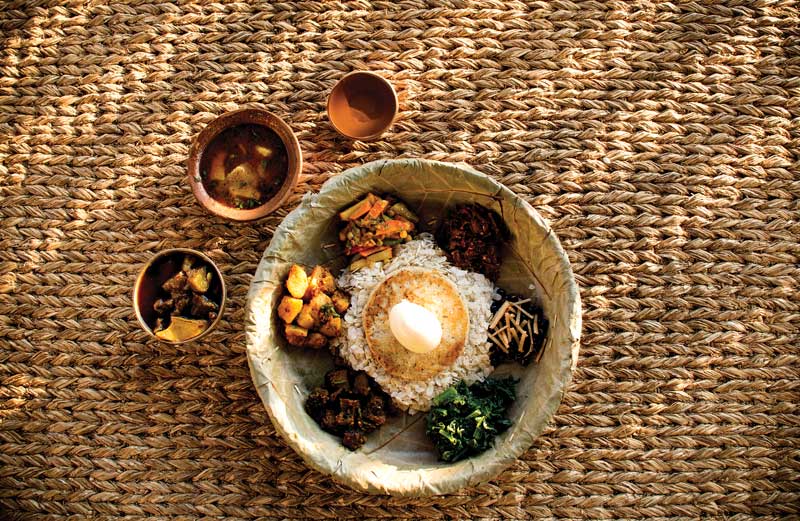Newa voye jonla
While decoding a newari feast was any easy, acknowledge some nutritional facts given by our dietitian, Ms. Kabita Maharjan advancing the authenticity of our Newa culture.

Food has its integral part in every culture. No different, Newa Culture considers different types of food for different occasions, considering the climate and nutritional change for a body. The different kind of food has a symbolic meaning and is renowned for spontaneous feast. Each dish has it’s symbolic representation and should be consumed as precisely to look after your fitness as directed by dietitian, Ms. Kabita Maharjan.
1. Baji
They are flattened rice beaten into dry, light flakes which is one the most important staple around Nepali cuisine. Basically rice grains are incorporated into everyday life, festivals and also rituals. Beaten rice is served best with curry, meat or yogurt. In 100 grams of beaten rice, there contains:
Carbohydrate: 77.9
Fat: 1.94
Protein: 7.68
Energy: 360
2. Chhoylā
A spicy buffalo meat, boiled and incorporated with unique and intense flavor which is one of the party topper dishes of all. Nepalese people are very fond of the flavor and can be also optioned for vegetarians like mushroom chhoylā. In 100 grams of lean meat, there contains
Carbohydrate: 0
Fat: 0.9
Protein: 19.4
Energy: 86
3. Tukan:chā
They are a type of spinach made more like a cold salad dressed with oil and salt. Nepalese consume rayo saag or rape leaves often. Personal favorite when mixed with beaten rice also a belief of eating some vegetables? Calculating it’s nutritional benefit, in 100 gms of rape leaves
Carbohydrate: 5.9
Fat: 0.4
Protein: 5.1
Energy: 48
4. Hāku Musyā
Hāku Musyā is roasted black soybean mixed with oil and salt placed on top of baji along with thin slices of ginger. Their existence delivers the genuine look of a newari cuisine. So, in 50 grams of black soyabean, there contains
Carbohydrate: 15.65
Fat: 7.5
Protein: 16.65
Energy: 196.5
5. Aachar
Normally they are relish made out of radish, carrots, boiled potatoes that are spicy, sour with a very pungent and distinctive flavor that helps to wake your taste buds in a good way.
6.Dāyekālā;
A very important dish of any newari cuisine, Dāyekālā which is buffalo meat gravy flavored with meat curry spices presenting the most superior taste of a newa feast. In 100 grams of lean meat, there contains
Carbohydrate: 0
Fat: 0.9
Protein: 19.4
Energy: 86
7. Aalu Aachar
It is boiled potato taken into whole other level. Boiled potatoes mashed into a spicy relish kind served just a little sour as it is or as any condiment. By calculating the each total amount of carbohydrate, fat, protein and energy from different ingredients mixed into this relish we get,
Carbohydrate: 16.76
Fat: 7.03
Protein: 2.51
Energy: 119.5
8. Chhon Kwā
This one has only one of its kind flavor and smell that might be not everyone’s favorite. This vegetable dish is made out of bamboo shots with potatoes and small beans. The perfect batch of chhon Kwā will make you fall for its flavorful, spicy, addictive taste found in almost every newari cuisine. From extracting each amount of nutrition of each ingredient used into this dish we calculated as,
-Found In 25 gms of bamboo shots
Carbohydrate: 1.42
Fat: 0.12
Protein: 0.09
Energy: 10.75
-found in 75 gms of potatoes
Carbohydrate: 16.8
Fat: 0.06
Protein: 1.2
Energy: 72.75
9. Wo
They are lentils, soaked overnight, grinded into a paste and fried into small cakes which complete a set of a samaybaji. It is considered to be the important dish to present ritually. In 50 grams of black gram dal later made into a paste has,
Carbohydrate: 29.8
Fat: 0.35
Protein: 6
Energy: 86.7
10. Dhau (yogurt)
Desserts are meant to clean your palette. One of the most recommended is dhau-baji, eaten around Nepal. Farmers are given a day just to enjoy the tangy-sweet-sour taste of yogurt mixed with flattened rice flakes. In 100 grams of yogurt you’ll get:
Carbohydrate: 3
Fat: 0.37
Protein: 0.98
Energy: 60
11. Aylā
A home-made drink popular as the local newari drink also originally served in a Sali, a small clay bowl poured from distinctive alcohol jar so called Anti. The tradition of pouring it from a height to bring fizz represents the quality of the drink. Besides the fact that drinking is injurious to health, every 30ml of homemade Aylā can give you 210 units of energy also will help you with digestion.
Source person: Ms. Kabita Maharjan


